The world of work is changing with the progression of digital transformation. An acceleration of this process is due to many lockdowns during the COVID-19 pandemic, when many workplaces had to reduce their operations or completely shut down, to respect the mandatory regulations and keep the workers safe.
Indeed, numerous companies around the world have learned from the WFH experience that productivity increased in some cases, and their employees don’t have to be bound by a physical workplace to work efficiently.
For sure, this might be one of the takeaways from the pandemic but, how to keep the good aspects of the WFH time? How minimize the negative effects of isolation and lack of social interaction?

WFH is an acronym for “Work From Home” which describes work done remotely, instead of inside an office.
Before the pandemic, there were far fewer people working from home. According to a survey by Gartner, after COVID- 19 was declared a pandemic, 88% of organizations around the world encouraged their employees to work from home or made it mandatory. That was luckily feasible because, while it is not possible to do several jobs remotely, many industries are capable of fully adopting a WFH model.
But it came with pros and cons: remote work can also result in feelings of social isolation and loneliness due to the individualization of work processes, with negative effects on the individual’s personal life. Collaboration is what suffers most when working remotely.
One of the takeaways of this challenging time, will not be “the death of the office” as some have suggested, and for the same reasons, Working From Home won’t become something entirely from the past.
More options will be available, for example, a structured hybrid model where, teams that thrive on collaboration, have mandatory times each week when everyone is expected to be in the office, or small teams working remotely from the same location.
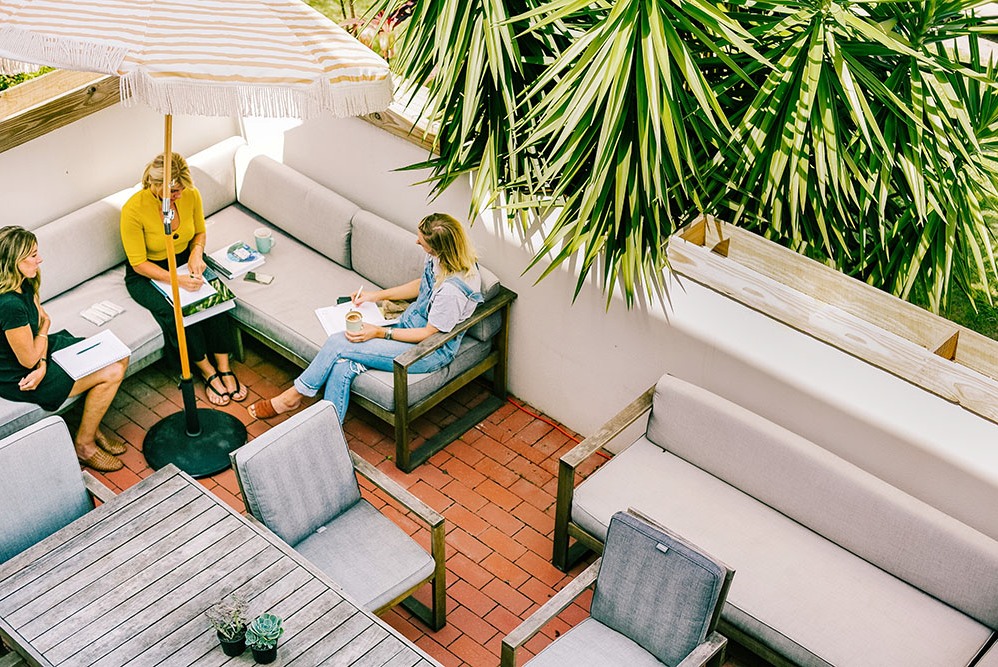
COWORKING AS A MIDDLE GROUND
With the pandemic having forced employees into the “world’s largest work-from-home experiment”[1], remote work processes are now advancing at a rapid pace.
These processes could continue raising awareness for the potential of coworking spaces in providing a flexible workspace for remotely working professionals. Space that allows them to be productive in a nearby area whilst circumventing feelings of social isolation or loneliness, interacting with like-minded others, enhancing feelings of belonging and connectedness.
Coworking is the middle ground between the office and home.
In recent months, the appeal of going into an office has already changed: it has become a place to meet colleagues, collaborate on projects, etc. But not anymore a place to go every day.
The global coworking space market was expected to grow from $7.97 billion in 2020 to $8.14 billion in 2021 at a compound annual growth rate (CAGR) of 2.1%[2].
The growth is mainly due to the companies resuming their operations and adapting to the new normal while recovering from the COVID-19 impact, which had earlier led to restrictive containment measures involving social distancing, remote working, and the closure of commercial activities that resulted in operational challenges.
Before the Covid-19 pandemic, the coworking industry has grown quickly as one of the fasted-growing markets globally. The pandemic, however, has brought the industry to an abrupt halt[3] because the coworking model heavily relies on the physical proximity of members to provide them with the benefits outlined above.
However, with the peak and the imposed restrictions, the industry’s spaces were forced to either rapidly adjust their business model, or to close the doors for their members, also depending on the gravity of the local circumstances. This is unprecedented for coworking spaces and had a tremendous economic impact on the industry. The current situation is also likely to initiate significant transformations for the concept of coworking, as well as to impact developments of the future of flexible work arrangements.
Whilst remote working processes are commonly in place within companies, such arrangements have only recently started to emerge for coworking spaces, emphasizing the need to study these collaborative environments and how they have developed during the pandemic.
Nevertheless, coworking spaces are exploring adaptations to their businesses with a strong shift to the digital environment.
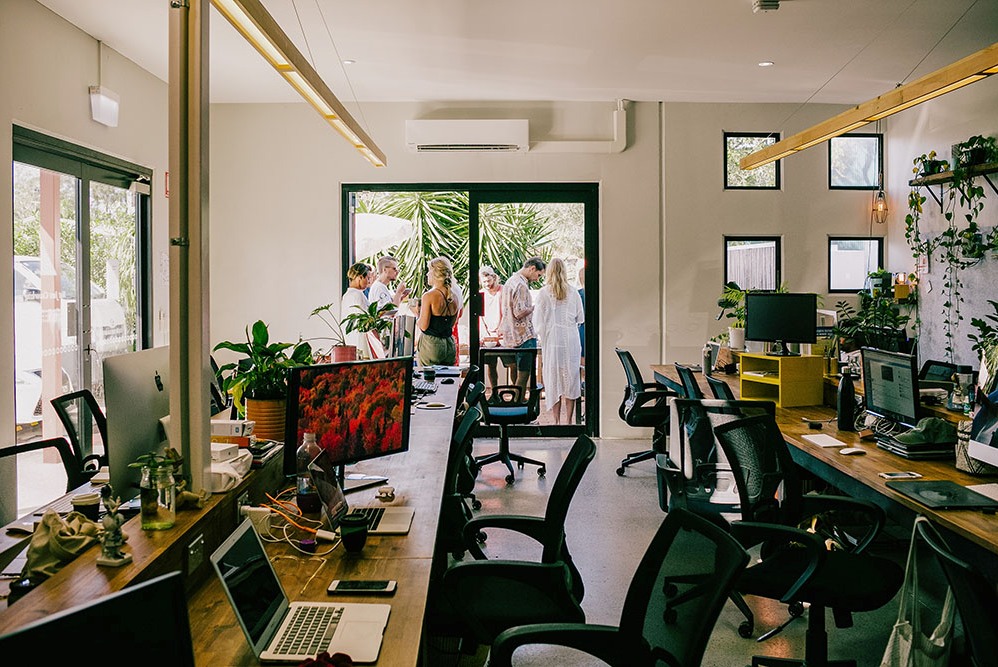
ADAPTATION IN ACTIVITIES AND DESIGN TO COVID-19 RESTRICTIONS[1]
The impact of the imposed restrictions regarding hygienic standards, social distancing, and limitations of social gatherings witnessed a shift in demand for the various configurations such as hot-desking, fixed desks, or offices.
Least affected by the increased hygienic standards, meaning more frequent cleaning and disinfection, the minimum distances of 1.5m between individuals were perceived to have a more negative impact.
After the strictest measures had been relieved, the demand situation appears to have shifted away from space for larger groups (meeting rooms, event space) to smaller, more flexible configurations, with evident increases in the areas of online memberships and virtual office services among others.
Restrictions for social gatherings, however, have the most affected the coworking spaces.
ADAPTATIONS IN DESIGNS
The flexibility that coworking has brought to the market is very much compatible with Covid-19 designs that are both sustainable and humane. Preferred characteristics include:
- no fixed desks;
- mobile technology;
- working in a setting that suits the mood and activity;
- sticky spaces for deep collaboration;
- blurring inside and outside;
- contact with wind, sun, and greenery, as well as mixing eating, working, and socializing;
- in the perspective of a so-called circular economy, a streamlined solution to sustainable workplace design such as using micro-harvesting of energy through solar panels and wind turbines.
READ MORE What makes a Sustainable Coworking Space?
WHICH ARE THE EXPECTATIONS FOR FUTURE DEVELOPMENTS?
The core value of the industry builds on the physical space, and the members being together. With governmental restrictions and social distancing measures in place, coworking spaces need to identify and employ new strategies to successfully adjust their practices for new and pressing circumstances.
The focus on the community also extends to social relations with other actors, and actively embraces changing dynamics in the environment, in the attempt to achieve social impact and economic sustainability together. The coworking model has now undergone rapid changes and continues to display fast transformations as the industry is grappling with pandemic-induced challenges.
As businesses have transformed from office culture to a mix of home, remote, and hub workplaces, flexibility is hardwired into the concept of more fluid and more inclusive workplaces that allow productivity and flexibility.
Lately, we witness a change in the demand for different coworking elements due to the future predictions of a shift in the use of coworking spaces by corporate remote teams frequenting them for their weekly meetings outside of their usual home office.
A consequence of this shift is that the impact on coworking operators will depend on how successfully they can present themselves as healthy places. Increasingly, they will also be defined in terms of the quality and health of the environment.
As technological solutions such as temperature scanning and contact tracing develop and become more widespread, some workers may seek out places that implement higher levels of monitoring.
On the demand side, it could also happen that the remote work experience opens employees’ eyes to its advantages and makes them want to continue afterward. That could mean working from home or working from the closest coworking space without the need for long daily commutes.
The shift to the digital realm may open up new markets for the coworking spaces that can attract new members through digital memberships only.
The first indications of companies allowing employees to choose between the home office and working from coworking spaces, as observed in some cities already, prove true, this may also help smaller independent spaces ensure business survival through this surge in demand from smaller companies as well.
Furthermore, making use of more group-focused coworking spaces as innovative office forms may allow organizations to benefit from knowledge exchange and social networking that may lead to improved organizational performance, as shown in business centers.
What is now crucial for the coworking spaces in the industry is adapting their operations and preparing for relevant eventualities, especially with virtual coworking and digital mediation mechanisms to maintain and build their community through an uncertain future.
Moreover, coworking spaces should re-thinking their spatial layout to ensure that governmental restrictions (e.g., sufficient distance between members), as well as general preventive measures (e.g., increased ventilation, and more outdoor air, avoiding recirculation; or installing air filtration systems), can more effectively be met to benefit from the co-location of members in the physical space.
Such adaptations may also add to the coworking space members’ feeling of security and their resulting willingness to frequent the space, ultimately mitigating the negative impact that working from home for extended periods would bring.
READ MORE What makes a Sustainable Coworking Space?
VIRTUAL COWORKING SPACES
Due to the pandemic, remote co-working spaces are also pivots of companies that were originally operating physical coworking spaces, with a strong expansion into the digital realm as a means to compensate for the lack of physical proximity and the resulting dynamics.
These online environments where people work together at the same time are based on platforms that allow the user to browse different spaces and to join the communal activities, as in the real life. Virtual coworking spaces have evolved to include many features that are associated with their physical counterparts.
For reference, the virtual event platform REMO and also the digital membership offered by Kolektif House in Istanbul with daily passes and access to a membership portal for collaborations with other members.
The pandemic has undoubtedly altered the way occupiers and experienced operators alike are revisiting space management today. However, it’s safe to say that flexibility coupled with the augmentation of modern technology will surely lead the sector to a strong revival in the months ahead. The future of coworking spaces does look exciting, with immense potential.
SUSTAINABILITY AND DESIGN IN COWORKING SPACES AROUND THE WORLD
The development of sustainable coworking spaces is a major trend shaping the industry’s market. They are implementing eco-friendly measures in the workplace to attract entrepreneurs concerned with environmental issues such as global warming.
Moreover, there are tons of concepts, adapted to the needs of each city and the local culture.
For many, it is now clear that moving towards a more sustainable business brings tangible benefits. Green coworking spaces are economically viable from the energy consumption point of view because the joint effort brings better results: those who decide to use coworking spaces as an office, probably are those conscious individuals who collaborate to reduce the carbon footprint. Indeed, common spaces can help do it in a much more efficient way.
Whilst the design and aesthetics of a coworking venue are essential to building the image and nurturing the feeling of community, the largest coworking spaces, utilize design to facilitate flexibility of use, offering more functions in the same building.
The aim is to keep members using and enjoying the venue throughout the day, thanks to a variety of spaces and environments.
Following are a few examples of coworking that put ecological design and environmental sustainability at the core of their model.
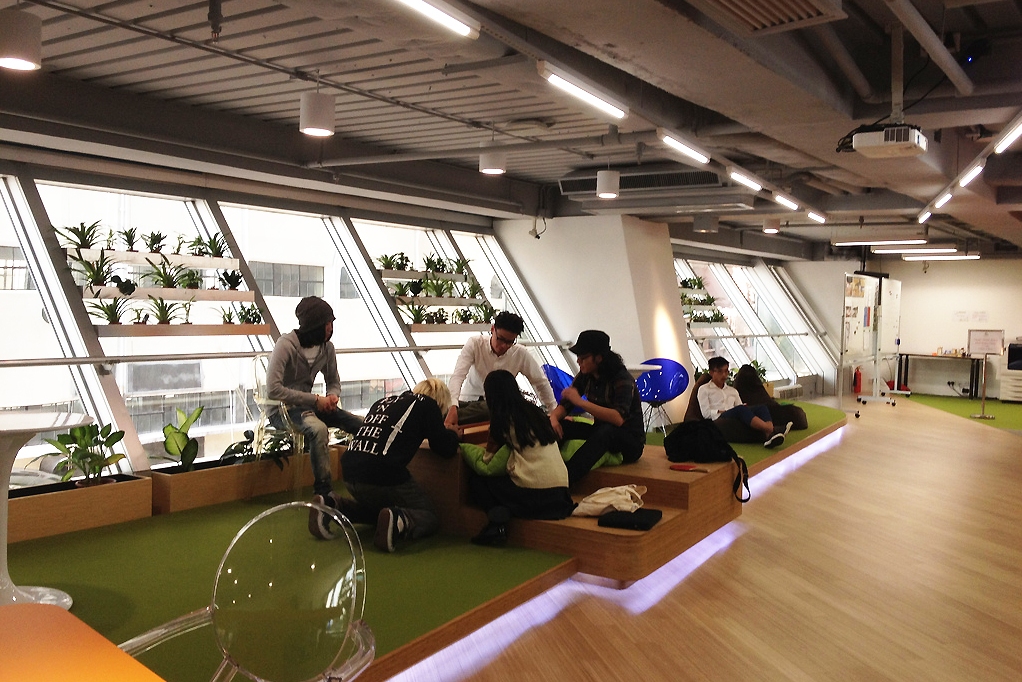
COMMUNITY FOCUSED – CoCoon (HONG KONG)
Based in Hong Kong, CoCoon is well-known because they provide networking events and numerous opportunities such as idea-sharing events that let professionals come together and find like-minded people. That leads to more innovations and eventual upgrades and improvements in performance.
From the environmental sustainability point of view, CoCoon in Hong Kong has a floor made of natural bamboo and uses non-toxic paints and LED lights that use less energy. The drought-resistant plants are a part of the design, making them sustainable and pleasing to the eye.
With 14 thousand square feet, it has a café, a library, a photo studio, conference rooms, and a comfy lounge room along with the interior coworking space.
Memberships are by invitation only. The application process is quite rigorous and the applicants are tested on their skills and talents.
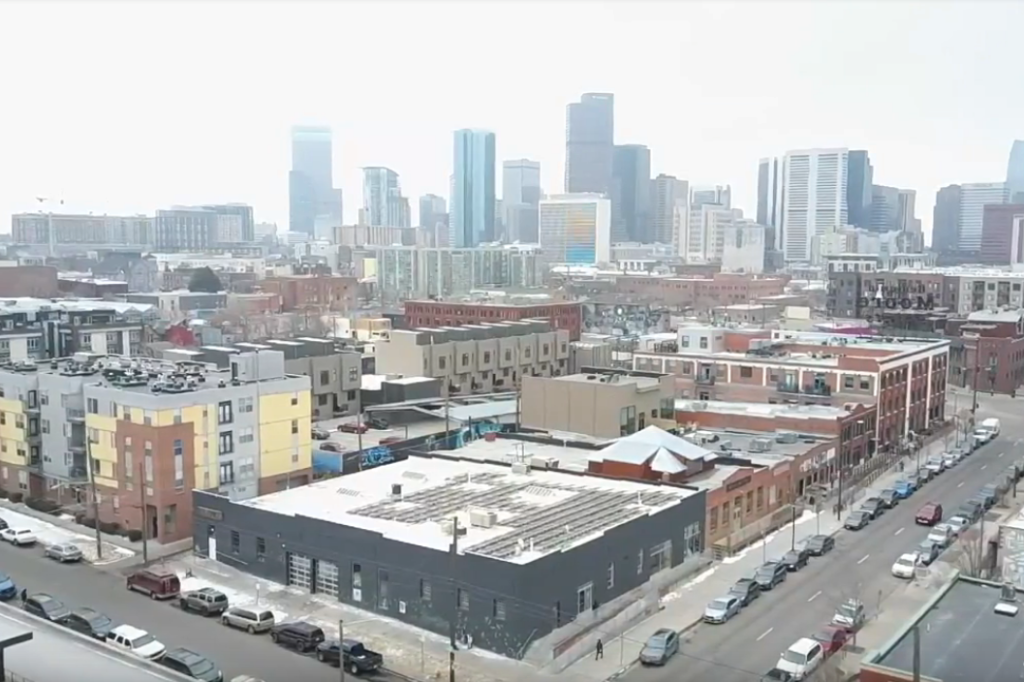
RENEWABLE ENERGY FOCUSED – GREEN SPACES (DENVER, USA)
Green Spaces is located in Denver and benefits from the partnership with the local communities. A special Certifiably Green Denver Program makes each member certified green.
It is one of the most innovative sustainable coworking spaces as it uses more than 160 solar panels on the roofs of the buildings where its offices are located. LED lighting and solar-powered electricity sources allow significant cost savings. The community is empowered by the zero-waste lifestyle: the management arranges the recycling and composting services in all coworking areas.
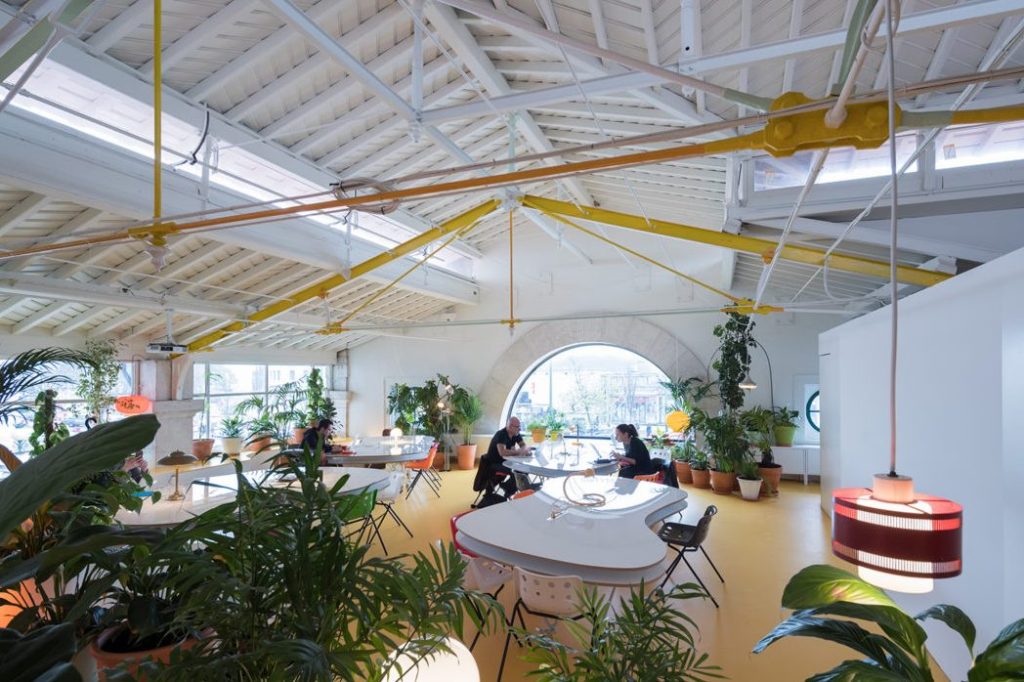
BIOPHILIC DESIGN FOCUSED – SECOND HOME (LONDON, LISBON, LOS ANGELES)
Biophilic design plays with the human biological affinity to connect with nature, creating calmer environments with higher levels of well-being and happiness. At the same time, the plants act as a noise reducer and space divider, all while improving air quality.
“it’s more than simply adding a few pot plants to a workspace.”
At Second Home – Lisbon, it feels more like entering a botanical garden than an office space where the line between private and working life blurs to make way for a sense of community and inspiring synergies, integrating educational, wellness, and cultural activities into the coworking experience.
According to their philosophy, the company states they always prefer to repair and breathe new life into forgotten buildings, drastically reducing the carbon footprint across co-working spaces.

With the co-working in Los Angeles, they have created LA’s densest urban forest by taking an old car parking lot and transforming it by planting over 6500 native Californian trees and plants.
Also on the technological side of energy-saving strategies, the Second Home spaces, provide smart solutions:
- the ‘bubble roof’ at Holland Park Home responds to weather in real-time, reducing the need for energy-intensive heating and cooling.
- the Lisbon roof automatically opens at night to let cool air in, then traps it by closing before sunrise.
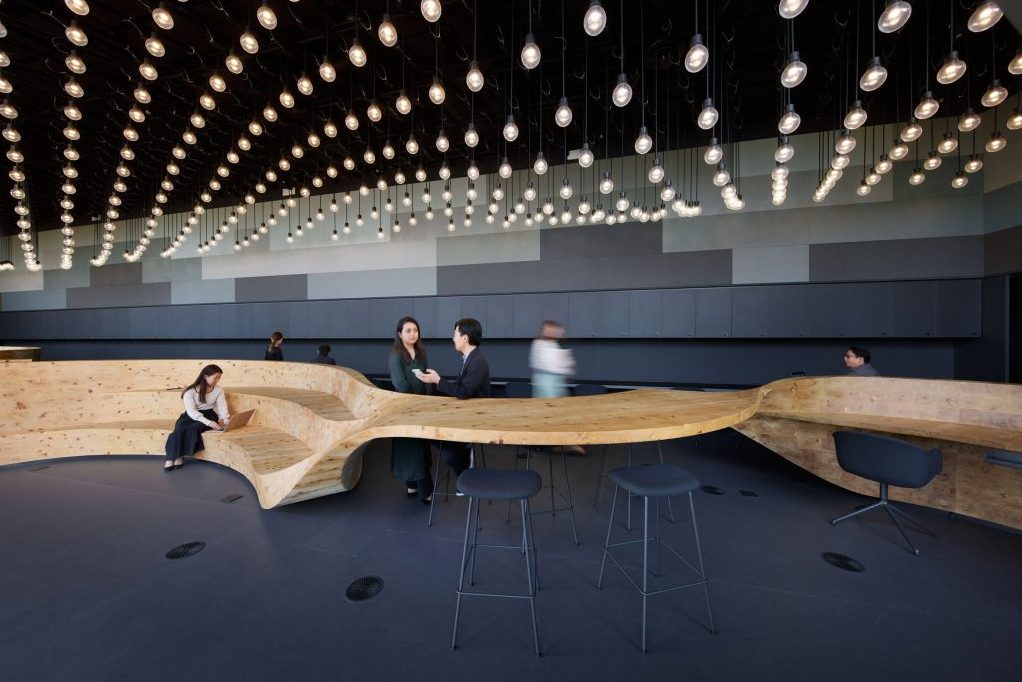
COLLABORATION AND COMMUNITY FOCUSED – PANGAEA (TOKYO, JAPAN)
Pangea, also spelled Pangaea, in early geologic time, was a supercontinent that incorporated almost all the landmasses on Earth. Its name is derived from the Greek pangaia, meaning “all the Earth.”
The supercontinent Pangaea acted as the conceptual starting point and also became the name of the new Digital Garage co-working space. As a boutique office for digital nomads,
“commemorates a time and place where geographical, political, and national constructs were not an obstacle.”
Located on the 10th floor of a new building complex in Shibuya, Tokyo, Digital Garage wanted to create a space that encourages people of different cultures and backgrounds to come together and collaborate.
Designed by Snøhetta, a “super furniture” inspired by a brushstroke makes up the heart of the office space.
Two large wooden objects curve through the entire space, serving various functions. They incorporate both seating areas and surfaces that can be used by numerous people simultaneously.
“The furniture also prompts its users towards a greater vision through daily interactions with the co-working space and one another”.
SUSTAINABLE LIFESTYLE FOCUSED – GARAGE SOCIETY (HONG KONG)
Coworking platform Garage Society, which has four locations in Hong Kong and a further three in Southeast Asia, has teamed up with urban farming outfit Rooftop Republic to offer an urban farming opportunity in central co-working space in Wan Chai.
The rooftop urban farm by the Rooftop Republic hosts a range of farming experience activities year-round and the company launches a new grow-your-own-veggies initiative in the heart of the city.
SUSTAINABLE BUSINESSES FOCUSED – SUSTAINABLE WORKSPACES (LONDON, UK)
Sustainable Workspaces in London is a co-working space specifically oriented on Sustainability.
They host a growing community of sustainable businesses by creating the ecosystem for cleantech and sustainability corporates and startups in the industries of:
- Agritech & Food
- Building Technology
- Future Energy
- Mobility
- Circular Economy
Here the entrepreneur can find like-minded people and the possibility of support by the resident Sustainable Ventures team, with expertise in sustainability, venture capital, and entrepreneurship.
IN CONCLUSION
We are assisting with a big shift in workplace policies. That is the expression of an existing need, pushed by the COVID-19 pandemic lockdowns and resulting WFH.
Many companies have adopted a hybrid model of work in the office and remote work to embrace the flexibility discovered in certain jobs.
Being physically in the workplace won’t be a thing of the past but, at the same time, won’t be anymore a daily habit, shifting from WFH to WFA (Work From Anywhere). In this context, the Coworking industry offers great solutions of flexibility, sociality and attention to Sustainability aspects as an expression of the Sharing Economy.
Thanks for reading, and feel free to add suggestions and comments.
ecoarchitecture.it
[1] Mayerhoffer, M., “The Impact of Covid-19 on Coworking Spaces: Evidence from Germany”, Journal of Corporate Real Estate, June 2021.
[1] Banjo, S., Yap, L., Murphy, C. and Chan, V. (2020), “Coronavirus Forces World’s Largest Work-From-Home Experiment”, Bloomberg.Com, 2 February, available at: https://www.bloomberg.com/news/articles/2020-02-02/coronavirus-forces-world-s-largest-work-from-home-experiment
[2] Coworking Space Global Market Report 2021: COVID-19 Growth and Change to 2030 – ResearchAndMarkets.com
[3] Mayerhoffer, M., “The Impact of Covid-19 on Coworking Spaces: Evidence from Germany”, Journal of Corporate Real Estate, June 2021.
SOURCES
Banjo, S., Yap, L., Murphy, C. and Chan, V. (2020), “Coronavirus Forces World’s Largest Work-From-Home Experiment”, Bloomberg.Com, 2 February, available at: https://www.bloomberg.com/news/articles/2020-02-02/coronavirus-forces-world-s-largest-work-from-home-experiment
Coworking Space Global Market Report 2021: COVID-19 Growth and Change to 2030 – ResearchAndMarkets.com
Hoffmann, J. (2020), “Coworking-Spaces: Die digitale Bohème und die Corona-Krise”, DIE WELT, 3 July, available at: https://www.welt.de/regionales/hamburg/article210868113/Coworking-Spaces-Die-digitale-Boheme-und-die-Corona-Krise.html
Mayerhoffer, M., “The Impact of Covid-19 on Coworking Spaces: Evidence from Germany”, Journal of Corporate Real Estate, June 2021.
Spinuzzi C., Working Alone Together: Coworking as Emergent Collaborative Activity, Journal of Business and Technical Communication, Vol. 26 No. 4, 2012.


